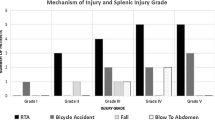Abstract
Purpose
Management of traumatic splenic injury may be operative or non-operative (including embolization and conservative management). Traditionally, haemodynamic instability has been an indication for operative intervention. We aimed to report our experience of managing traumatic splenic injury at a regional major trauma centre in the UK over a 4-year period, with a particular focus on the non-operative management (NOM) of haemodynamically unstable patients.
Methods
All patients with splenic injuries admitted to North Bristol NHS Trust from April 2012 to March 2016 were included. Patients were classified for analyses by injury severity (low or high grade), haemodynamic instability (defined as a reverse shock index < 1) and management category (operative or non-operative).
Results
106 patients were included. Overall 85.8% of patients received NOM: 79.2% conservative and 6.6% interventional radiology. Two patients (2.4%) managed conservatively required further intervention. Haemodynamically stable and unstable patients were equally likely to receive NOM (89.7 and 81.3% respectively, p = 1). All unstable patients with low-grade injuries were managed conservatively and only one (2.7%) required further intervention. Two unstable patients with high-grade injuries (28.6%) underwent NOM successfully.
Conclusions
These data support the safe application of non-operative management to haemodynamically unstable patients with traumatic splenic injury, particularly in those with low-grade injuries. Additional prospective work is required to define the subgroup of patients for whom this is appropriate and to determine the long-term outcomes of NOM.



Similar content being viewed by others
References
Davis JJ, Cohn I, Nance FC. Diagnosis and management of blunt abdominal trauma. Ann Surg. 1976;183:672–8.
Brady RR, Bandari M, Kerssens JJ, Paterson-Brown S. Parks RW Splenic trauma in Scotland: demographics and outcomes. World J Surg. 2007;31:2111–6.
Department for Transport. Reported road casualties in Great Britain, annual report: 2016. https://www.gov.uk/government/statistics/reported-road-casualties-great-britain-annual-report-2016. Accessed 17 Jan 2018.
Hildebrand DR, Ben-Sassi A, Ross NP, Macvicar R, Frizelle FA, Watson AJ. Modern management of splenic trauma. BMJ. 2014;348:g1864.
Cirocchi R, Boselli C, Corsi A, et al. Is non-operative management safe and effective for all splenic blunt trauma? A systematic review. Crit Care. 2013;17:R185.
Sinha S, Raja SV, Lewis MH. Recent changes in the management of blunt splenic injury: effect on splenic trauma patients and hospital implications. Ann R Coll Surg Engl. 2008;90:109–12.
Schnüriger B, Inaba K, Konstantinidis A, Lustenberger T, Chan LS, Demetriades D. Outcomes of proximal versus distal splenic artery embolization after trauma: a systematic review and meta-analysis. J Trauma. 2011;70:252–60.
Stassen NA, Bhullar I, Cheng JD, et al. Selective nonoperative management of blunt splenic injury: an Eastern Association for the Surgery of Trauma practice management guideline. J Trauma Acute Care Surg. 2012;73:S294–300.
Moore EE, Cogbill TH, Jurkovich GJ, Shackford SR, Malangoni MA. Champion HR Organ injury scaling: spleen and liver (1994 revision). J Trauma. 1995;38:323–4.
Lai WH, Rau CS, Hsu SY, et al. Using the reverse shock index at the injury scene and in the emergency department to identify high-risk patients: a cross-sectional retrospective study. Int J Environ Res Public Health. 2016;13:357.
Heuer M, Taeger G, Kaiser GM, et al. No further incidence of sepsis after splenectomy for severe trauma: a multi-institutional experience of the trauma registry of the DGU with 1,630 patients. Eur J Med Res. 2010;15:258–65.
Scarborough JE, Ingraham AM, Liepert AE, Jung HS, O’Rourke AP, Agarwal SK. Nonoperative management is as effective as immediate splenectomy for adult patients with high-grade blunt splenic injury. J Am Coll Surg. 2016;223:249–58.
Chastang L, Bège T, Prudhomme M, et al. Is non-operative management of severe blunt splenic injury safer than embolization or surgery? Results from a French prospective multicenter study. J Visc Surg. 2015;152:85–91.
Olthof DC, van der Vlies CH, Goslings JC. Evidence-based management and controversies in blunt splenic trauma. Curr Trauma Rep. 2017;3:32–7.
Olthof DC, Sierink JC, van Delden OM, et al. Time to intervention in patients with splenic injury in a Dutch level 1 trauma centre. Injury. 2014;45:95–100.
Hughes J, Scrimshire A, Steinberg L, et al. Interventional radiology service provision and practice for the management of traumatic splenic injury across the Regional Trauma Networks of England. Injury. 2017;48:1031–4.
Acknowledgements
We gratefully acknowledge the contribution of Emily Batt to this work.
Author information
Authors and Affiliations
Corresponding author
Ethics declarations
Conflict of interest
R Armstrong, A Macallister, B Walton and J Thompson declare that they have no conflict of interest.
Ethical approval
For this type of study formal consent is not required.
Informed consent
The Trauma Audit and Research Network has given ethical approval (Section 251) for research on the anonymized data submitted by member hospitals. Local approval was granted by The Quality Assurance and Clinical Audit Department (reference CE6572).
Rights and permissions
About this article
Cite this article
Armstrong, R.A., Macallister, A., Walton, B. et al. Successful non-operative management of haemodynamically unstable traumatic splenic injuries: 4-year case series in a UK major trauma centre. Eur J Trauma Emerg Surg 45, 933–938 (2019). https://doi.org/10.1007/s00068-018-0975-y
Received:
Accepted:
Published:
Issue Date:
DOI: https://doi.org/10.1007/s00068-018-0975-y




